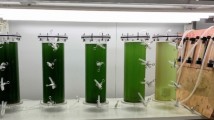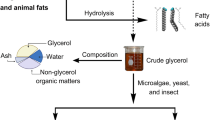Abstract
Glycerol from biodiesel production was used as a substrate for valerate production in a 13.1-L anaerobic filter with an open microbiome. Ethanol at 15% of the influent chemical oxygen demand was supplemented as an additional electron donor source. The 114-day experimental period was divided in three phases which included initial adaptation phase, external sludge addition from a caproic acid producing reactor and valerate extraction using a pertraction system. Propionate (0.63–1.75 g COD L−1 day−1) and valerate (0.86–1.81 g COD L−1 day−1) were the main carboxylates formed throughout all operational phases. An increase in production rates of butyrate (0.26–0.31 g COD L−1 day−1), caproate (0.01–0.08 g COD L−1 day−1), and 1,3-propanediol (0.43–0.52 g COD L−1 day−1) was observed with addition of external caproic acid producing sludge rich in Clostridium members. In the operational phase with pertraction, a sudden decrease in 1,3-propanediol and concomitant increase in acid production were verified. Propionate and valerate reached higher production rates compared with the other two phases, suggesting that the pertraction system favored the oxidative pathway of glycerol fermentation. Valerate extraction reached a maximum of 30 g COD m−2 day−1. The filter microbiome was highly diverse with Simpson index values close to 0.1 for the four sludge samples collected, and a concomitant increase in Megasphaera elsdenii and an increase in valerate production rates were observed. Hence, high valerate production and extraction rates through the carboxylate platform are a feasible alternative for crude glycerol valorization with a great potential for improvement in future research.




Similar content being viewed by others
Change history
11 November 2019
The original version of this article unfortunately contained a mistake in Figure 2.
References
Agler MT, Wrenn BA, Zinder SH, Angenent LT (2011) Waste to bioproduct conversion with undefined mixed cultures: the carboxylate platform. Trends Biotechnol 29:70–78. https://doi.org/10.1016/j.tibtech.2010.11.006
Agler MT, Spirito CM, Usack JG, Werner JJ, Angenent LT (2012) Chain elongation with reactor microbiomes: upgrading dilute ethanol to medium-chain carboxylates. Energy Environ Sci 5:8189. https://doi.org/10.1039/c2ee22101b
Angenent LT, Richter H, Buckel W, Spirito CM, Steinbusch KJJ, Plugge C, Strik DPBTB, Grootscholten TIM, Buisman CJ, Hamelers HVM (2016) Chain elongation with reactor microbiomes: open-culture biotechnology to produce biochemicals. Environ Sci Technol 50:2796–2810. https://doi.org/10.1021/acs.est.5b04847
ANP - National Agency of Oil, Natural Gas and Biofuels (Brazil) (2018) Brazilian statistical yearbook of oil, natural gas and biofuels, 1st edn. National Agency of Oil, Natural gas and biofuels, Rio de Janeiro (in Portuguese)
APROBIO - Associação dos Produtores de Biodiesel do Brasil (2018). https://aprobio.com.br/2018/04/19/producao-de-biodiesel-deve-ser-de-5-bilhoes-de-litros-em-2018/. Accessed 17 Aug 2018 (in Portuguese)
Arslan D, Steinbusch KJJ, Diels L, Hamelers HVM, Strik DPBTB, Buisman CJN, Wever H (2016) Selective short-chain carboxylates production: a review of control mechanisms to direct mixed culture fermentations. Crit Rev Environ Sci Technol 46:592–634. https://doi.org/10.1080/10643389.2016.1145959
Biebl H, Menzel K, Zeng AP, Deckwer WD (1999) Microbial production of 1,3-propanediol. Appl Microbiol Biotechnol 52:289–297. https://doi.org/10.1007/s002530051523
Bornstein BT, Barker HAA (1948) The energy metabolism of Clostridium kluyveri and the synthesis of fatty acids. J Biol Chem 172:659–669
Botton V, Souza RT, Wiggers VR, Scharf DR, Simionatto EL, Ender L, Meier HF (2016) Thermal cracking of methyl esters in castor oil and production of heptaldehyde and methyl undecenoate. J Anal Appl Pyrolysis 121:387–393. https://doi.org/10.1016/j.jaap.2016.09.002
Burniol-Figols A, Varrone C, Le SB, Daugaard AE, Skiadas IV, Gavala HN (2018) Combined polyhydroxyalkanoates (PHA) and 1,3-propanediol production from crude glycerol: selective conversion of volatile fatty acids into PHA by mixed microbial consortia. Water Res 136:180–191. https://doi.org/10.1016/j.watres.2018.02.029
Cavalcante WA, Leitão RC, Gehring TA, Angenent LT, Santaella ST (2017) Anaerobic fermentation for n-caproic acid production: a review. Process Biochem 54:106–119. https://doi.org/10.1016/j.procbio.2016.12.024
Chen WS, Ye Y, Steinbusch KJJ, Strik DPBTB, Buisman CJN (2016) Methanol as an alternative electron donor in chain elongation for butyrate and caproate formation. Biomass Bioenergy 93:201–208. https://doi.org/10.1016/j.biombioe.2016.07.008
Corma A, Oliver-Tomas B, Renz M, Simakova IL (2014) Conversion of levulinic acid derived valeric acid into a liquid transportation fuel of the kerosene type. J Mol Catal A Chem 388–389:116–122. https://doi.org/10.1016/j.molcata.2013.11.015
EBB - European Biodiesel Board Statistics (2019). http://www.ebb-eu.org/stats.php. Accessed 29 July 2019
Ganigué R, Naert P, Candry P, Smedt J, Stevens CV, Rabaey K (2019) Fruity flavors from waste: a novel process to upgrade crude glycerol to ethyl valerate. Bioresour Technol 289:121574. https://doi.org/10.1016/j.biortech.2019.121574
Ge S, Usack J, Spirito CM, Angenent LT (2015) Long-term n-caproic acid production from yeast-fermentation beer in an anaerobic bioreactor with continuous product extraction. Environ Sci Technol 49:8012–8021. https://doi.org/10.1021/acs.est.5b00238
Grootscholten TIM, Steinbusch KJJ, Hamelers HVM, Buisman CJN (2013a) Chain elongation of acetate and ethanol in an upflow anaerobic filter for high rate MCFA production. Bioresour Technol 135:440–445. https://doi.org/10.1016/j.biortech.2012.10.165
Grootscholten TIM, Steinbusch KJJ, Hamelers HVM, Buisman CJN (2013b) High rate heptanoate production from propionate and ethanol using chain elongation. Bioresour Technol 136:715–718. https://doi.org/10.1016/j.biortech.2013.02.085
Jankowska E, Duber A, Chwialkowska J, Stodolny M, Oleskowicz-Popiel P (2018) Conversion of organic waste into volatile fatty acids: the influence of process operating parameters. Chem Eng J 345:395–403. https://doi.org/10.1016/j.cej.2018.03.180
Kim H, Jeon BS, Sang B (2019) An efficient new process for the selective production of odd-chain carboxylic acids by simple carbon elongation using Megasphaera hexanoica. Sci Rep 9:11999. https://doi.org/10.1038/s41598-019-48591-6
Kucek LA, Nguyen M, Angenent LT (2016a) Conversion of L-lactate into n-caproate by a continuously fed reactor microbiome. Water Res 93:163–171. https://doi.org/10.1016/j.watres.2016.02.018
Kucek LA, Spirito CM, Angenent LT (2016b) High n-caprylate productivities and specificities from dilute ethanol and acetate: chain elongation with microbiomes to upgrade products from syngas fermentation. Energy Environ Sci 9:3482–3494. https://doi.org/10.1039/C6EE01487A
Kucek LA, Xu J, Nguyen M, Angenent LT (2016c) Waste conversion into n-caprylate and n-caproate: resource recovery from wine lees using anaerobic reactor microbiomes and in-line extraction. Front Microbiol 7:1–14. https://doi.org/10.3389/fmicb.2016.01892
Leitão RC, Gehring TA, Cavalcante WA, Freitas IBF, Souza AC, van Haandel AC, Angenent LT, Santaella ST (2017) Biological production of caproic acid in a lab-scale reactor. Embrapa Agroind Trop (Tech Rep) 229:1–6 (ISSN 1679-6535 [in Portuguese])
Leng L, Yang P, Mao Y, Wu Z, Zhang T, Lee PH (2017) Thermodynamic and physiological study of caproate and 1,3-propanediol co-production through glycerol fermentation and fatty acids chain elongation. Water Res 114:200–209. https://doi.org/10.1016/j.watres.2017.02.023
Leng L, Nobu MK, Narihiro T, Yang P, Tan GA, Lee P (2019) Shaping microbial consortia in coupling glycerol fermentation and carboxylate chain elongation for co-production of 1,3-propanediol and caproate: pathways and mechanisms. Water Res 148:281–291. https://doi.org/10.1016/j.watres.2018.10.063
Marchandin H, Juvonen R, Haikara A (2009) Megasphaera. In: de Vos P, Garrity GM, Jones D, Krieg NR, Krieg NR et al (eds) Bergey’s manual of systematic bacteriology, vol Three: The Firmicutes, 2nd edn. Springer, Berlin
Marounek M, Fliegrova K, Bartos S (1989) Metabolism and some characteristics of ruminal strains of Megasphaera elsdenii. Appl Environ Microbiol 55:1570–1573
Monteiro MR, Kugelmeier CL, Pinheiro RS, Batalha MO, César AS (2018) Glycerol from biodiesel production: technological paths for sustainability. Renew Sustain Energy Rev 88:109–122. https://doi.org/10.1016/j.rser.2018.02.019
OECD/FAO (2017) Agricultural outlook 2017–2026. OECD Publishing, Paris. https://doi.org/10.1787/agr_outlook-2017-en
Prabhu R, Altman E, Eitemana MA (2012) Lactate and acrylate metabolism by Megasphaera elsdenii under batch and steady-state conditions. Appl Environ Microbiol 78:8564–8570. https://doi.org/10.1128/AEM.02443-12
Silva GP, Mack M, Contiero J (2009) Glycerol: a promising and abundant carbon source for industrial microbiology. Biotechnol Adv 27:30–39. https://doi.org/10.1016/j.biotechadv.2008.07.006
Sun YQ, Shen JT, Yan L, Zhou JJ, Jiang LL, Chen Y, Yuan JL, Feng EM, Xiu ZL (2018) Advances in bioconversion of glycerol to 1,3-propanediol: prospects and challenges. Process Biochem 2018(71):134–146. https://doi.org/10.1016/j.procbio.2018.05.009
Veras STS, Rojas P, Florencio L, Kato MT, Sanz JL (2019) Production of 1,3-propanediol from pure and crude glycerol using a UASB reactor with attached biomass in silicone support. Bioresour Technol 279:140–148. https://doi.org/10.1016/j.biortech.2019.01.125
Viana QM, Viana MB, Vasconcelos EAF, Santaella ST, Leitão RC (2014) Fermentative H2 production from residual glycerol: a review. Biotechnol Lett 36:1381–1390. https://doi.org/10.1007/s10529-014-1507-4
Weimer PJ, Moen GN (2013) Quantitative analysis of growth and volatile fatty acid production by the anaerobic ruminal bacterium Megasphaera elsdenii T81. Appl Microbiol Biotechnol 97:4075–4081. https://doi.org/10.1007/s00253-012-4645-4
Weimer PJ, Nerdahl M, Brandl DJ (2015) Production of medium-chain volatile fatty acids by mixed ruminal microorganisms is enhanced by ethanol in co-culture with Clostridium kluyveri. Bioresour Technol 175:97–101. https://doi.org/10.1016/j.biortech.2014.10.054
Wu Q, Bao X, Guo W, Wang B, Li Y, Luo H, Wang H, Ren N (2019) Medium chain carboxylic acids production from waste biomass: current advances and perspectives. Biotechnol Adv 37:599–615. https://doi.org/10.1016/j.biotechadv.2019.03.003
Acknowledgements
The authors are thankful to the Brazilian agencies, EMBRAPA (Empresa Brasileira de Pesquisa Agropecuária), call 11/2012-MP3; CNPq (National Council for Scientific and Technological Development), Projects Nr. 472420/2013-5 and 401394/2014-0; FACEPE (Fundação de Amparo à Ciência e Tecnologia do Estado de Pernambuco), Process Nr. IBPG-0194-3.07/14; and CAPES (Coordenação de Aperfeiçoamento de Pessoal de Ensino Superior), process PDSE (Programa de Doutorado Sanduíche) Nr. 88881.134642/2016-01; the Spanish Ministerio de Economía y Competitividad (MINECO-FEDER/EU, CTM-2013-44734-R) and the program of Cooperación Interuniversitaria con América Latina UAM-Santander (CEAL-AL/2017-14) for the technical and financial support. The valuable collaboration of colleagues during the experimental and analytical work in the laboratories of Embrapa Agroindústria Tropical (Fortaleza CE, Brazil), Federal University of Pernambuco (Recife PE, Brazil) and Autonomous University of Madrid (Madrid, Spain), is highly appreciated and acknowledged.
Author information
Authors and Affiliations
Corresponding author
Additional information
Editorial responsibility: Josef Trögl.
Electronic supplementary material
Below is the link to the electronic supplementary material.
Rights and permissions
About this article
Cite this article
Veras, S.T.S., Cavalcante, W.A., Gehring, T.A. et al. Anaerobic production of valeric acid from crude glycerol via chain elongation. Int. J. Environ. Sci. Technol. 17, 1847–1858 (2020). https://doi.org/10.1007/s13762-019-02562-6
Received:
Revised:
Accepted:
Published:
Issue Date:
DOI: https://doi.org/10.1007/s13762-019-02562-6





